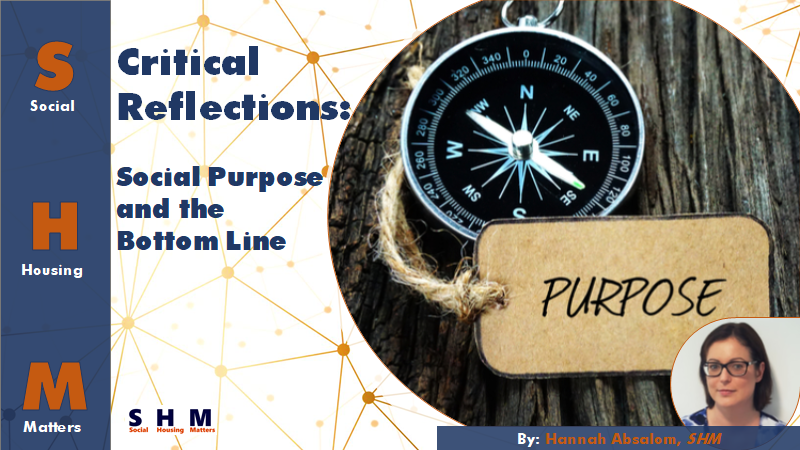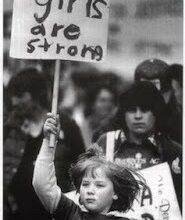By: Hannah Absalom

Reflecting on Caroline’s article here about whether we have a social purpose in social housing or if it is a myth inspired this short article. This article considers how the research participants for my PhD thesis talked about social purpose, or more accurately when reflecting on conversations with housing practitioners, a smooth alignment of ‘social purpose and the bottom line’. Conversations with tenants suggested that financialisation of the sector dominated and any authentic social purpose had long since vanished. The article will start with considering what the effects and reasons are of thinking about the ‘social purpose and bottom line’ as a singular aim. It will then consider what a social purpose disconnected from ‘bottom line’ financial thinking might look like. It will then conclude with what may need to change if we are to create a reality from the myth of a pure ‘social purpose in social housing’.
Creating problems – seeing the social purpose and bottom line in tension, not as a unified aim
It seems to me that talking about the social purpose of housing in the same breath as the bottom line is an emerging property of the privatisation of social housing that started in the 1980s and continues at a rapid pace. Prior to this, public housing had a political purpose and was tied to political notions of universal rights. Marketisation saw this erode, and the idea of universal rights replaced with ideas of financial efficiencies for the taxpayer. No longer was money to be spent on ensuring basic shelter, but money was to be saved for the benefit of ‘the taxpayer’.
This cultural shift saw new work practices develop and different approaches to assessing where the value of social housing work lay. Organisations were expected to adopt private sector practices and measure their performance for ‘value for money’ and efficiencies. As time wore on interests shifted from organisational efficiencies to the delivery of social activities, many of which used to be the responsibility of the state. This saw housing providers take on responsibilities for ‘more than’ housing and this included neighbourhood and community development, benefits and money advice, employment and ‘health and wellbeing’ initiatives. Anyone interested in just the financial bottom line and responsibly managed organisations would question the legitimacy of social landlords taking on former state responsibilities. The language of ‘social accounting’ and ‘corporate social responsibilities’ permitted these additional responsibilities to be reframed as good governance.
Surprisingly for the social housing sector, much critiqued for being behind the curve of change, the changes in what is considered to be ‘good governance’ gave it a head start on the private sector. New governance and stewardship codes see the formalisation of Environmental, Social and Governance (ESG) expectations that place the extremely wealthy private sector in the same location as social landlords – thinking about the social value of their work and the financial bottom line. Make no mistake, we are in a new era of governance with private actors and organisations, rather than the State and the third sector, taking on responsibilities for determining what is of social value and how much it is worth.
So, what might be wrong with this?
So far this blossoming culture is being spoken of in positive terms as aligning the sector with private funding partners and so introducing a new era of funding for the sector. Allowing it to get on with the task of building new ‘affordable’ homes. The first concern I have is the lack of anchoring of the definition of social purpose with ideas of what it means to lead a good and fulfilling life. While ‘social purpose’ is tied to ‘the bottom line’ we are not thinking about what a good life is, in and of itself. By tying its definition with money, we curtail our ability to be creative and imagine better futures.
A second concern is linked to the way social value is measured. While it is anchored to ‘the bottom line’ there is an implicit bias towards quantitative and financial measures of ‘success’. Social value gets defined by what fits well on a spreadsheet, rather than what fits well in real life. Tied to this second concern is a third, that of who gets to decide what is of social value? We already know social housing has a long history of paternalism that expresses as a distant and asymmetrical relationship between the tenant and the landlord. In this context, who is it who gets to decide the social value? What’s worth spending money on to contribute to a numerically constrained idea of a better life? This leads us to the final point; social problems are extremely complicated. While social value is tied to the bottom line, it makes it impossible to see this. There is a bias towards quantitative measures and ‘experts’ rather than tenants setting agendas. This fosters a culture that celebrates what looks successful rather than engaging in real world messiness where success is elusive and open to interpretation and contestation.
I argue that the proliferation of added value projects that look exactly the same evidence the lack of creativity and engagement with good life social purpose grounded in the real world rather than the twin demands of the market and the State. So, if thinking in terms of ‘social purpose and bottom line’ as one, singular problem effectively produces a performance of social purpose, what might actually thinking only of ‘social purpose’ produce?
Thinking from the starting point of a singular ‘social purpose’
Before you think, ‘ah that’s lovely for you, you can have those thoughts, we have got the serious business of housing to get on with’, I draw your attention to the book ‘Lost in Control’ by Wouter Hart. His book evidences the value to an organisation in a clearly defined, singular, social purpose. In fact, it can save you money. He argues that ensuring organisation work is aligned to a clear purpose, money is spent on meeting this, and savings made by not spending money on work that adds no value to this purpose. It can be done and is proven to work.
Leading on from Wouter’s point, thinking of social purpose first allows us to think more freely about how our work can contribute to a good life. It provides opportunities to truly and meaningfully engage tenants and other stakeholders on what this means. This provides new opportunities for collaboration that can help undermine the legacy of paternalism that is shot through the sector and change what we mean by ‘expertise’. Lived experience, rather than technical skills and aptitude are of equal, if not more importance from this perspective. It also identifies where we are wasting our energies, so once we have refined a social purpose, we can remove activity that does not help it get met. Thinking solely of social purpose means thinking about measurement completely differently. This requires new skills in social housing, and bravery to move away from the false comfort and cold reassurance provided by numbers. Social purpose thinking seems to align more with qualitative and experience-based measures. No, I don’t mean ‘customer experience’, I mean the actual experiences we have as human beings and what experiences aligned to a good life may look like and be measured.
A sign of thinking of singular ‘social purpose’ is the proliferation of projects that look different. They are tied to their contexts and the people within them. In summary they would be creative, open and collaborative. Constantly in movement and development as the confidence of participants to imagine and work towards a social purpose tied to good life, rather than the bottom line, grows.
What needs to change for a good life social purpose to happen?
The complex and most resilient barrier to thinking in terms of a social purpose not connected to the financial is our culture. It is not just ‘the state’, or ‘the private sector’ who we can point fingers at. We are as responsible for believing in the myth of the benefits of marketisation. For forgetting that we can think differently about what we want our purpose to be. Saying that, I know from conversations with participants, there are very real barriers to separating off ‘social value’ from money. The sector is doubly held to account by government. It is assessed for financial viability, and actively encouraged to take on further state responsibilities. This suggests there is scope for sector leaders and tenant organisations to ask government to give the sector space and freedom to reconnect with a grounded good life social purpose, and not get penalised for doing so.
Returning to the point made about the growth of ESG frameworks. Another opportunity lies in using this new context of developing relationships with the private sector. New measurement frameworks are getting developed. Now is the time to build in new thinking from disciplines such as environmental psychology and human geography that consider the influence of environments, emotions, history and cultural values. How better understanding of these may shift our understanding into new and creative territories. The case has already been made in Wouter Hart’s work for thinking about a singular social purpose separate from the bottom line as being good for businesses, organisations and people. If the case is already made there, it is time to be brave and turn the myth of social purpose into the reality of how we can imagine and work towards a good life.
About the author
Hannah Absalom is a former social housing practitioner and childhood resident of council housing. She is now studying a PhD in Human Geography that examines the use of behavioural insights in social housing. She is passionate about social housing being better and has academic interests in context, cognition and authentic, rather than performative, social change. She can sometimes be found on Twitter @HousingHannah expressing unpopular opinions about over-polarised issues. She’s available for training and consultancy work at Hannah@TrainandConsult.co.uk



